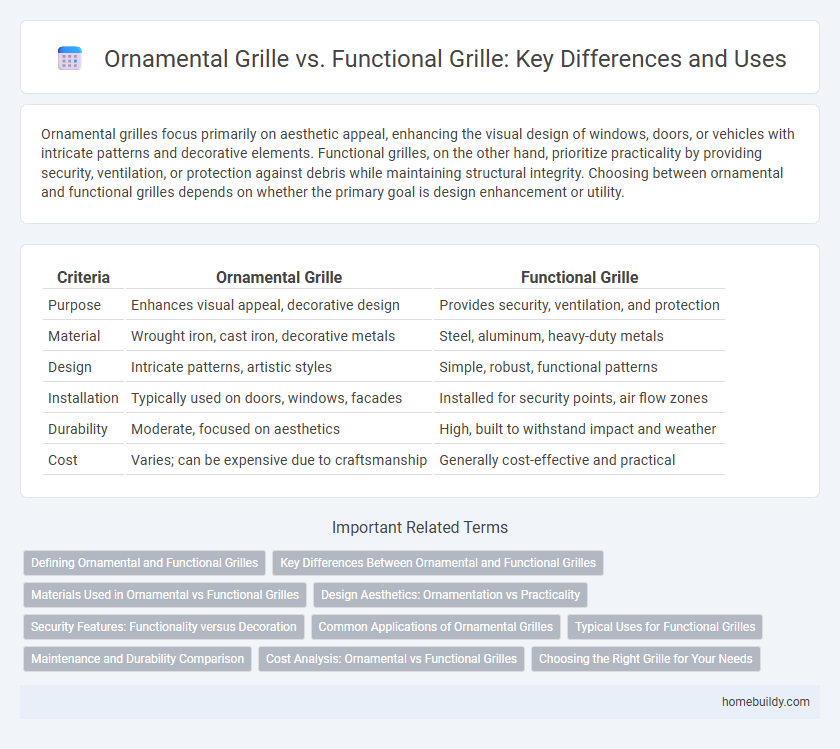Ornamental grilles focus primarily on aesthetic appeal, enhancing the visual design of windows, doors, or vehicles with intricate patterns and decorative elements. Functional grilles, on the other hand, prioritize practicality by providing security, ventilation, or protection against debris while maintaining structural integrity. Choosing between ornamental and functional grilles depends on whether the primary goal is design enhancement or utility.
Table of Comparison
| Criteria | Ornamental Grille | Functional Grille |
|---|---|---|
| Purpose | Enhances visual appeal, decorative design | Provides security, ventilation, and protection |
| Material | Wrought iron, cast iron, decorative metals | Steel, aluminum, heavy-duty metals |
| Design | Intricate patterns, artistic styles | Simple, robust, functional patterns |
| Installation | Typically used on doors, windows, facades | Installed for security points, air flow zones |
| Durability | Moderate, focused on aesthetics | High, built to withstand impact and weather |
| Cost | Varies; can be expensive due to craftsmanship | Generally cost-effective and practical |
Defining Ornamental and Functional Grilles
Ornamental grilles are designed primarily for aesthetic enhancement, featuring intricate patterns and decorative elements that complement architectural styles. Functional grilles prioritize utility, serving roles such as ventilation, security, or protection, often constructed from durable materials like metal or reinforced plastic. The distinction lies in ornamental grilles enhancing visual appeal, while functional grilles focus on practicality and safety.
Key Differences Between Ornamental and Functional Grilles
Ornamental grilles primarily serve decorative purposes, featuring intricate patterns and elegant materials to enhance aesthetic appeal in architectural design. Functional grilles focus on practicality, providing ventilation, protection, and security by allowing air flow while blocking debris or unauthorized access. Key differences include design complexity, material choice, and the balance between visual appeal and performance efficiency.
Materials Used in Ornamental vs Functional Grilles
Ornamental grilles commonly utilize materials such as wrought iron, brass, and aluminum, chosen for their decorative appeal and ability to be intricately shaped. Functional grilles, often crafted from steel, stainless steel, or durable plastics, prioritize strength, corrosion resistance, and ventilation efficiency over aesthetics. Both types may feature powder-coated finishes to enhance durability and weather resistance in various applications.
Design Aesthetics: Ornamentation vs Practicality
Ornamental grilles emphasize intricate design aesthetics with decorative patterns that enhance architectural beauty and style. Functional grilles prioritize practicality through features like ventilation, security, and durability, often with simpler, more utilitarian designs. Balancing aesthetics and functionality depends on the intended use and environmental requirements.
Security Features: Functionality versus Decoration
Ornamental grilles prioritize intricate design and visual appeal, often made from wrought iron or decorative metals to enhance aesthetics without significantly reinforcing security. Functional grilles focus on robust materials like steel or reinforced aluminum, incorporating bars or mesh patterns designed to resist forced entry and enhance property protection. Security features in functional grilles include tamper-resistant fasteners, impact-resistant coatings, and installation methods that prevent removal or bypass, contrasting with ornamental grilles that emphasize decorative elements over physical security.
Common Applications of Ornamental Grilles
Ornamental grilles are commonly used in residential and commercial architecture to enhance aesthetic appeal while maintaining airflow and security. These decorative elements often appear in windows, doors, and ventilation covers, featuring intricate designs crafted from wrought iron, aluminum, or steel. In contrast to functional grilles that prioritize protection and ventilation efficiency, ornamental grilles serve primarily as visual statements complementing interior and exterior design themes.
Typical Uses for Functional Grilles
Functional grilles are primarily used in HVAC systems to regulate airflow and maintain indoor air quality in residential, commercial, and industrial spaces. They are commonly installed in walls, ceilings, and floors to facilitate ventilation, heating, and cooling while preventing debris intrusion. These grilles also serve crucial roles in server rooms, factories, and public buildings where controlled air distribution is essential for safety and equipment performance.
Maintenance and Durability Comparison
Ornamental grilles, crafted from decorative metals such as wrought iron or brass, require regular cleaning and periodic sealing to prevent rust and maintain aesthetic appeal, which can increase maintenance efforts compared to functional grilles. Functional grilles, typically made from durable materials like aluminum or stainless steel, emphasize corrosion resistance and structural integrity, offering greater longevity with minimal upkeep. The maintenance and durability of ornamental grilles depend heavily on environmental exposure and protective coatings, while functional grilles prioritize low-maintenance performance in demanding conditions.
Cost Analysis: Ornamental vs Functional Grilles
Ornamental grilles generally incur higher costs due to intricate designs, premium materials, and detailed craftsmanship, often used for aesthetic enhancement in architectural projects. Functional grilles prioritize durability and airflow efficiency, typically made from simpler, cost-effective materials like aluminum or steel, resulting in lower installation and maintenance expenses. Budget considerations must balance the premium investment in decorative appeal against the practicality and affordability of functional grille solutions.
Choosing the Right Grille for Your Needs
Choosing the right grille depends on balancing aesthetic appeal with functionality; ornamental grilles offer intricate designs that enhance visual appeal, while functional grilles prioritize airflow, durability, and protection. Consider factors such as ventilation requirements, material strength, and maintenance needs to ensure the grille fulfills its intended purpose effectively. Selecting between ornamental and functional grilles influences both the overall look and practicality of your space.
ornamental grille vs functional grille Infographic

 homebuildy.com
homebuildy.com